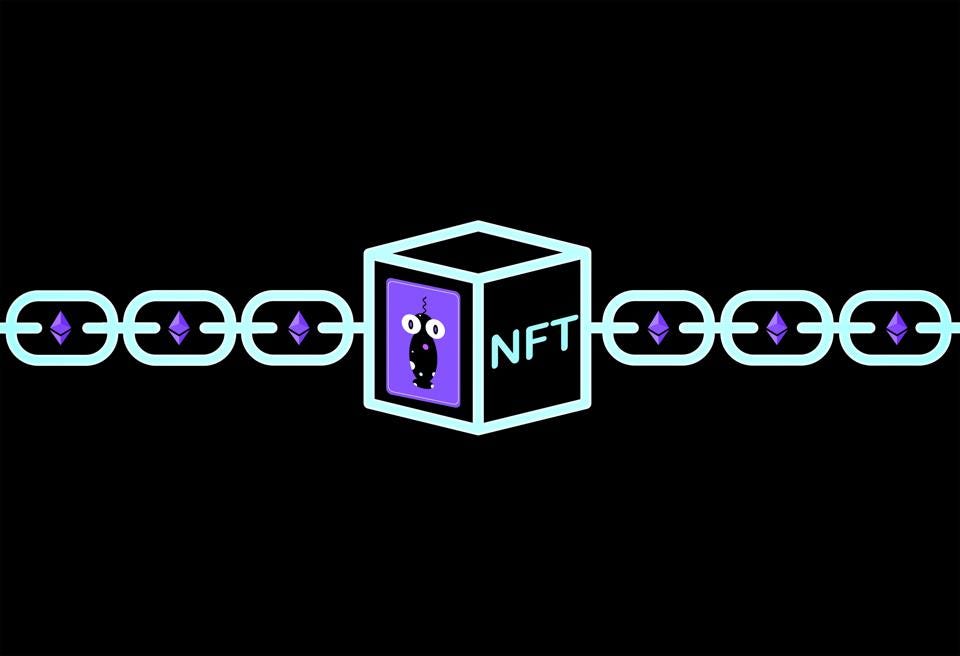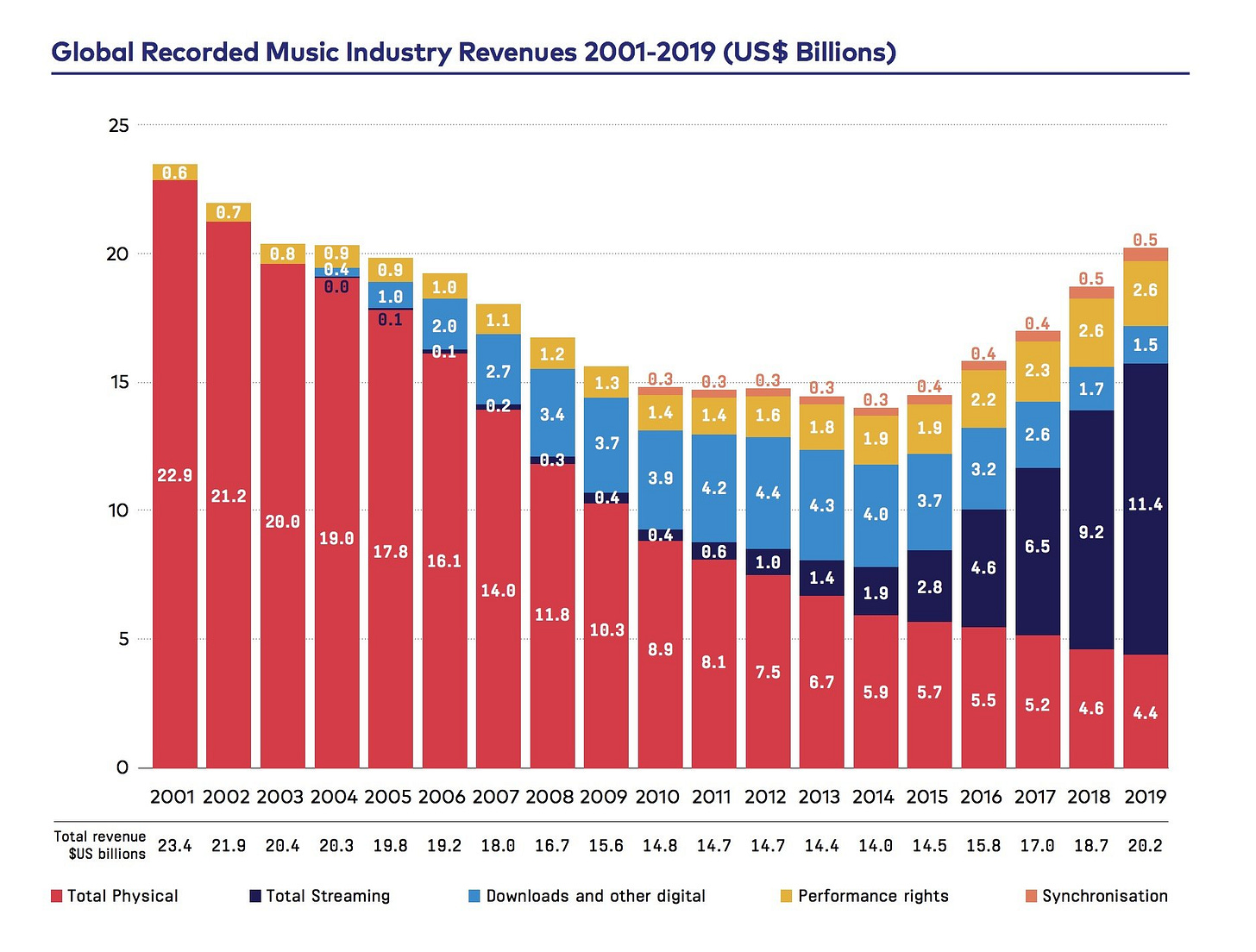Web3 and the Golden Age of Music 🤘
Friday 21st May, 2021
Thought for the week 💭
Web3 → growth in the music industry
[3-minute read]
Web3 will lead to totally new business models in the music industry. New business models can make or break industries.
For example, the introduction of free-to-play in gaming led to market revenues growing by 3x. In 2010, free-to-play represented only 20% of the gaming industry’s revenues. Today, it represents >85% of industry revenue. In the same time period, the market has grown from ~$50bn to >$150bn.
The music industry shifted its business model over the past two decades too - moving from an ownership model (CDs and downloads) to an access model (streaming).
However, as can be seen in the chart below, this did not lead to the same meteoric growth as the gaming industry’s business model innovation. Instead, it simply put out the fire that piracy was causing for the industry.
I believe that Web3 will change the fortunes of the music industry. Specifically, through the use of Web3 instruments like NFTs, social tokens and micropayments, the music industry will be better able to monetise underserved customer segments.
The combination of these factors could conceivably lead to digital music revenues increasing by 2-3x over the next decade - akin to the growth of the gaming industry.
Currently underserved segments
The current monetisation method of digital streaming platforms is ‘one size fits all’:
Pricing: Sell a fixed-price ($9.99/month) subscription to as wide of an audience as possible. Run this for as long as possible, before moving downmarket by introducing discounts and bundles. Reduce ARPU in the process.
User segments: All users are born equal. They receive the same features and are monetised equally.
This is suboptimal, in my view. For example, it is strange that the feature set (and therefore ARPU) of ‘laid back listeners’ is the same as that of ‘superfans’.
Surely the industry can get more creative?
Here are 2 user segments that I think crypto instruments can better serve:
1. Superfans
Who are they
Hardcore music fans who are obsessed with an artist(s) and want to showcase their fandom. They want to spend money to support the creators and artists they love. They want to showcase their fandom publicly. This segment would like to spend more on music than the flat $9.99/month that they currently pay for a subscription.
How can they be better served with Web3
1//NFTs
NFTs - non-fungible tokens - a way to make digital assets scarce and ‘ownable’. They are cryptographic assets that signify ownership of digital media. Similar to physical goods like limited-edition sneakers, these digital items are distinguishable from one another by a serial number. The “serial number” for NFTs is their token ID, which is stored on the blockchain. The data that lies within each NFT token is unique, thus making each NFT token in existence completely exclusive. See my post on this here for a good overview.
A superfan can collect and showcase their favourite music via NFTs. People have always collected physical music in the form of vinyl records and CDs. NFTs enable the collection of digital music - most likely in the form of a WAV/MP3/MP4. Fans will not have the ability to ‘feel’ their NFTs in the same way that they can touch and hold a record IRL. However, this lost value is outweighed by a number of benefits that are unique to digital assets. For example, this digital asset can be adaptive - rather than static (ie it can change over time or based on certain contextual factors such as time of day). The song could be interactive - enabling users to modify it in some way. The NFT could consist of both audio and video (ushering a potential resurgence of the golden age of music videos). This is all really exciting potential value creation for the superfan.
2// Micropayments:
Micropayments - A micropayment is a financial transaction involving a very small sum of money. For the purposes of this post, I define this as a payment under $1. I believe that most of the interesting benefits emerge at a cost far below this - in the range of $0.001-0.1. See my post on this here for a good overview.
As with many areas of consumer software, China has been far more innovative in its monetisation of music streaming, which has led to significantly better outcomes for streaming platforms than the West. In Tencent Music’s case, only 30 percent of their revenue comes from subscriptions, music downloads, and advertising revenue. 70% comes from fan-to-creator micropayments. These micropayments take the form of donations from fans or payment for virtual goods (e.g. skins for the app or exclusive content). The implementation of micropayments in the West is currently inhibited by high transaction costs and lack of interoperability between platforms. However, cryptocurrencies offer an elegant solution to these problems and off-chain solutions like Lightning for Bitcoin and Raiden for Ethereum already allow near-instant payments with incredibly low transaction fees by removing the need for intermediaries. If/when micropayments are implemented, this will be another useful tool for superfans to express their fandom (and increase their ARPU).
2. Speculators
Who are they
Music fans who back their own taste in music - so much so that they would be willing to invest their own money in promising artists with the expectation of making a financial return in the future.
How can they be better served with Web3
1// Social tokens:
Social tokens - also known as personal tokens, community coins, and creator coins - are an emerging category of digital assets. These tokens are backed by the reputation of an individual, brand or community. They are like owning shares in a person or a community, rather than a company. See my post on this here for a good overview.
Right now, scouting and investing in artists is restricted to A&R and music industry professionals. However, crypto and social tokens would democratise this - allowing anyone to speculate on the future potential of artists. For example, a music fan might spot a promising new musician on a streaming platform. They may have the view that this creator will explode in popularity in the future. To capitalise on this thesis, they would buy the artist’s coin and hold it until it appreciates in value (as more fans start to buy the artist’s coin). At that point, they would sell it in order to make a profit. Imagine being one of the early ‘investors’ in Lil Nax X or Travis Scott? Social tokens add new, more complex financial instruments to the music industry which will have the effect of increasing the overall ‘liquidity’ in the ecosystem. Good liquidity is an important component of any well functioning economic system. It enables more participants, and therefore, more money to flow into the system. Overall, this should lead to more activity in the music industry. In turn, this will facilitate more creation and more innovation in the space.
Concluding thoughts
The music industry has been notoriously slow to innovate. Increasingly outdated business models have prevented it from experiencing the same growth as other areas of the digital media landscape. However, crypto/Web3 instruments offer an exciting path forward. I’m excited about the inevitable innovation over the next twelve months in this space.



